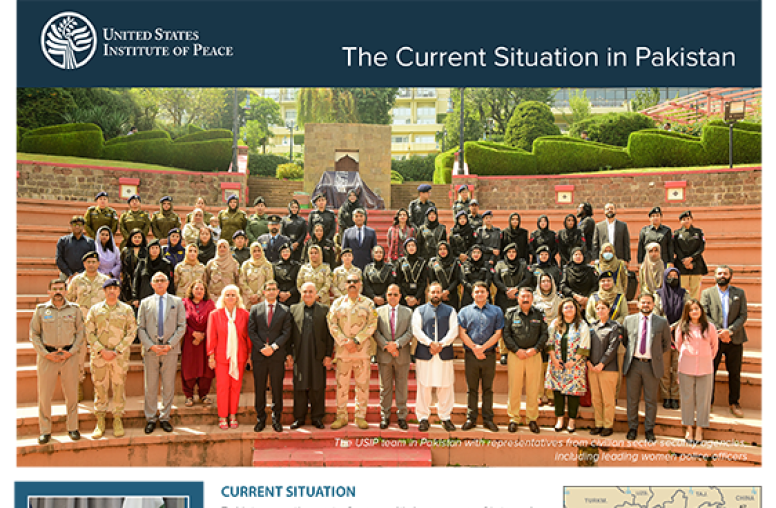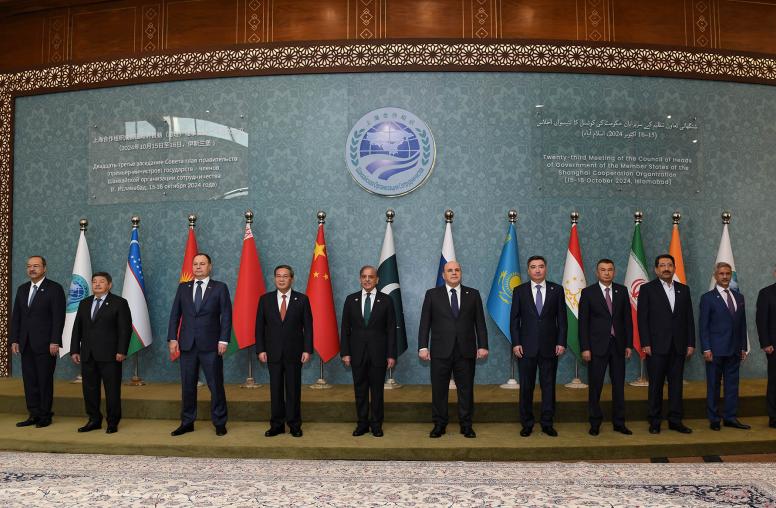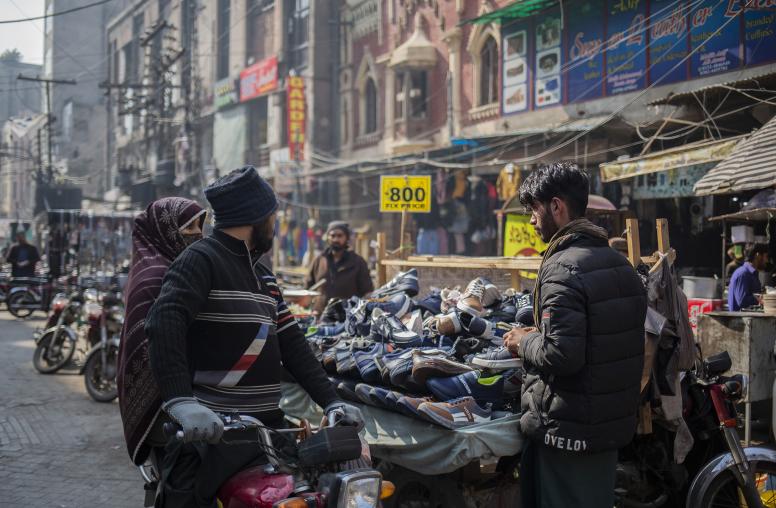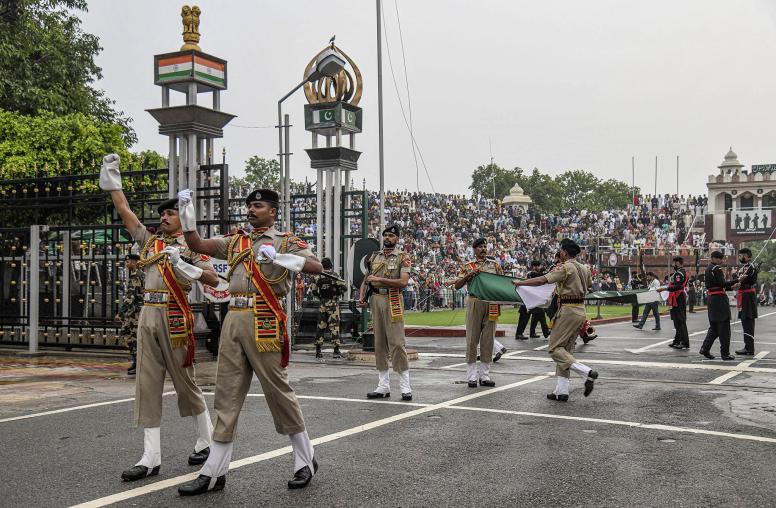In Karachi, Flooding Lays Bare City’s Governance Issues
Weeks after historic rainfall, fractured local governance has left some sections of Pakistan’s largest city still recovering.
Many parts of Pakistan have always struggled with flooding, especially over the last decade, due in part to climate change as weather events have become more extreme. But for Pakistan’s largest city Karachi, August saw immense rainfall—breaking all previous records in the past century—and widespread flooding that brought the city to a standstill. USIP’s Jumaina Siddiqui and Cyril Almeida look at why Karachi’s flooding situation is so dire, how contentious political dynamics have impeded governance reforms in the city, and what can be done to prevent future humanitarian disasters.

Pakistan faces problems with monsoons and flooding every year, why was the situation in Karachi so dire this time?
Siddiqui: While other parts of the country endured record rainfall as well, the flooding was minimal—like in the case of Lahore, where the water had all drained away within 24-36 hours thanks to improved infrastructure.
Karachi was the absolute opposite. With sustained rainfall over the course of the entire month, over 40 people died as a result of the flooding, negatively impacting an economy that was already struggling to recover as a result of the COVID-19 pandemic. Even weeks later, some areas are still feeling the impact of the flooding and citizens fear that any further rainfall could bring the city to a standstill once again.
This flooding impacted both urban and rural areas. In urban centers, the flooding is due mainly to poor infrastructure and lack of a proper solid waste management system. In rural areas, this flooding impacts rivers and irrigation canals, adversely affecting both industry and agriculture alike.
Even areas where the flood waters have reduced or receded, the garbage and sewage remain—leaving a secondary health nightmare for the most impoverished communities in Karachi. People from all socioeconomic strata struggled to find clean drinking water during the flood, and some areas are still struggling. In addition to no clean drinking water and unsanitary conditions, citizens continue to face electricity shortages as well. The flooding of homes has created significant homelessness, especially in the kachi abadis (slum areas). All of these problems stem from the city being poorly governed and exploited by multiple political parties vying for control of the city’s economic resources, but all failing to deliver basic services to its residents.
The political dimensions of the governance problems in Karachi are long-standing and seemingly intractable. Why has it been so difficult to find a reasonably effective governance strategy in Karachi?
Almeida: Pakistan’s largest city has outsized political problems. It has been virtually impossible to align the city, provincial, and national governments—in addition to the civil- and military-run administrative divisions in the city—in a sustainable manner. Politically, Karachi had been dominated by the Muttahida Qaumi Movement (MQM) since the 1980s, but a state-led operation since 2013 has dismantled the party. Its remnants, the various MQM factions, have been unable to band together, leaving a power vacuum in the city. Pakistan’s 2018 general elections saw the nationally ruling Pakistan Tehreek Insaaf (PTI) party capture a majority of seats in Karachi, but many of the winners were first-time candidates and political novices without governance experience.
A second problem is the political dynamics of Sindh: urban, Urdu-speaking Karachi votes one way; rural, Sindhi-speaking Sindh votes another way. Over the last three elections, the Pakistan People’s Party’s (PPP) dominance of rural Sindh has allowed it to lead the provincial government while having a relatively small voter base in Karachi. So, despite being the provincial capital, the country’s most populous city, and the primary residence for most of Sindh’s political leaders, Karachi’s urban problems are often not of direct political consequence to the provincial government.
A third problem is center-province tensions. When rival parties lead the federal and Sindh governments, as is the case with the PTI and PPP at present, Karachi is left in limbo when it comes to the funding and implementation of large infrastructure projects and urban overhaul.
Finally, there is the administrative jigsaw that is Karachi itself, with overlapping and intersecting areas of civilian and military administration in the city. City-wide storm water drainage, for example, is near-impossible to plan in the presence of rival and overlapping administrative fiefdoms, a by-product of the geographical expansion of Karachi and the creation of military-run upscale housing areas.
Karachi, as a megacity, has undergone unchecked growth and urbanization. The floods have put this into stark light, with both elites and the average resident protesting the government’s response—or lack thereof. How will this exacerbate tensions within the city?
Siddiqui: In their efforts to clean the nalas (drainage canals)—one of the causes of the historic flooding this past month—local government authorities in Karachi demolished a number of illegal settlements and commercial areas. Some of this demolition had started before the floods and before the pandemic, which had already created an uproar among small business owners. However, the demolition of homes during the floods creates a greater likelihood for a humanitarian crisis in a city already struggling to recover from both the floods and the COVID-19 economic crisis.
The problem in Karachi is that various local government entities have allowed rapid and massive construction of housing areas, apartment buildings, and commercial buildings without any consultation with the offices and departments that have purview over the projects and without any environmental impact oversight. Over time, the illegally built homes blocked the drainage waterways (and their associated garbage and sewage) along the nalas.
Most of the elites in Karachi, in general, couldn’t be less bothered by the illegal construction or its subsequent destruction. However, these floods impacted both the elites and the average person alike—city-wide power outages and flooding did not discriminate by economic status this time around. For the first time in recent memory, we saw the elite of Karachi protesting for lack of services.
Could this crisis become a catalyst for positive change in the megacity? What are the prospects for an improvement in governance and service delivery in Karachi?
Almeida: As noted above, the rain and its aftermath were indiscriminate in affecting Karachi. Commercial, industrial, and residential areas—both affluent and poor—all suffered, and in some cases for days and weeks. Unified in outrage, the city’s beleaguered residents were offered some immediate help: The army chief and prime minister visited Karachi and pledged military and federal resources to aid with the clean-up and cleared choked drainage systems, and a new administrator for the city has been appointed by the Sindh provincial government.
If there is to be durable change in Karachi, an empowered city government is the most likely path. But city governance is only a third of the local government system, below the federal and provincial tiers. And in Sindh, fresh political battle lines are being drawn with local government elections on the cards. The PTI wants a local government system with more resources and greater autonomy and has legally challenged the system introduced by the PPP, which concentrated power at the provincial tier. For its part, the PPP wants a dispute over the 2017 census resolved before the next local government elections are held in Sindh, which is a potentially fraught issue that will determine the official size of Sindh’s population versus the rest of Pakistan and urban Sindh’s population versus rural Sindh—all issues that affect apportionment of electoral districts at all levels.
An activist judiciary is likely to try and break the political deadlock, but better governance in Karachi is unlikely to be delivered by judicial fiat. Karachi’s troubles are far from climate-related alone: The city is in the grips of a prolonged electricity crisis and a gas crisis is expected to intensify this winter. Perhaps a perfect storm of troubles will force the political leadership to find a modicum of relief for Karachi.



